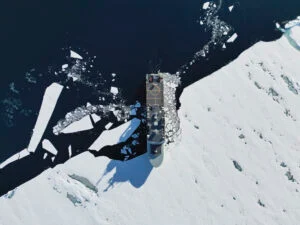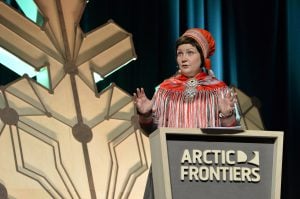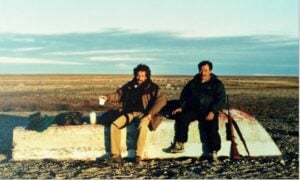
People & Culture
On thin ice: Who “owns” the Arctic?
As the climate heats up, so do talks over land ownership in the Arctic. What does Canadian Arctic Sovereignty look like as the ice melts?
- 4353 words
- 18 minutes
This article is over 5 years old and may contain outdated information.
People & Culture

A missing family member. A chance meeting in a northern Canadian town. A clock with a connection to the lost Franklin Expedition. Canadian-born author Ed O’Loughlin’s third novel, Minds of Winter, has all the hallmarks of a page-turning mystery, but it’s the way he weaves these elements into an eloquent exploration of mortality, memory and loss that has earned the book a place on the 2017 Scotiabank Giller Prize shortlist.
O’Loughlin, a former journalist and self-professed map fanatic who now lives in Dublin, Ireland, is among the new Fellows nominated to The Royal Canadian Geographical Society this year. Here, he discusses the imaginative feat that is Minds of Winter and his fascination with cartography.
On the inspiration for Minds of Winter
I’ve had a lifelong interest in winter that grew into a fascination with the North and the polar regions and polar exploration, so part of it was trying to figure out where that came from and where it would take me. The poles seem to be a kind of otherworld that exists on the planet, an uncanny place where things aren’t as they appear. I was interested in the way they could be used as a metaphor for the exploration of the boundary between life and death. Perhaps part of it was also that I missed memories of proper winters in Canada. I moved away when I was young and we really didn’t have a lot of snow in Ireland, but I was able to go and visit it every day when I was writing; it was kind of an adventure holiday without leaving my room.
On experiencing the Arctic for the first time
I made a trip to the Arctic in 2011, travelling from Whitehorse up through the Yukon and into the Northwest Territories to the Mackenzie delta and the Arctic Ocean, trying to get a feel for what it was like up there in midwinter. For starters, it’s very, very beautiful. People don’t seem to go there much in winter and they should, I think, just to get a sense of the scale of Canada and the North. It’s vast. I was blown away by the beauty of it, and the remoteness and the quiet, and the kind of slow, buttoned-up pace of life people up there have in winter. There’s almost an expectancy to it; it feels like something’s going to happen, but it never does.
On imagining a backstory for a mysterious Franklin expedition artifact
“Arnold 294” was a government-owned, Royal Naval chronometer — basically a high-precision clock that was issued to the Franklin expedition as it was leaving London in 1845. It was one of several that was issued to the expedition from the Royal Observatory at Greenwich to help them keep time and know exactly where they were, and unlike everything else on the Franklin ships, it survived in one piece. It should have been lost in the Arctic along with everything and everyone else, but it turned up at auction a few years ago in England, in one piece, working, and having been disguised to look like a different kind of clock. It seemed like someone probably knew what it was and had deliberately hidden its identity, perhaps because they knew it was government property and should have been handed back in. It became a fascinating mystery to me, how this artifact that, officially at least, sailed off into the unknown and was lost forever, made its way back when nobody and nothing else did. They have a theory, and it’s a lot more plausible than the one I come up with in the story I tell, but there’s still quite a long chain of supposition in it, so I don’t find it particularly satisfying. I prefer to print the legend.
On the allure of maps
Like a lot of people, I’ve always loved looking at maps. A map of the world is supposedly a scientific object — it’s telling you, “This is what’s there, and this is what we know.” And yet when you look at one, the first thing you tend to do is start wandering away from what you know and imagining other places: Timbuktu, Samarkand, Ellesmere Island. You start escaping into the map. There’s a real dichotomy between the supposed purpose and the emotional reality of a map. Maps are always constructed for a particular purpose, but they’re not ever a faithful representation of reality because they’re a two-dimensional abstraction of a three-dimensional truth. They’re full of escapes and tricks and little cracks and trap doors you can slip away through.
On his favourite map
When I was a kid, we had a plate with a map on it. It was a 1967 commemorative plate that was done up for the centennial of Confederation to look like a kind of 19th-century engraving. It was very whimsical — it had little bowhead whales in Baffin Bay and people paddling around Lake Athabasca in canoes, and beavers and bears here and there. It wasn’t a very good map and it was pretty twee, but as a kid I loved looking at it. That’s the first map I can remember staring at with a sense of wonder.
Are you passionate about Canadian geography?
You can support Canadian Geographic in 3 ways:

People & Culture
As the climate heats up, so do talks over land ownership in the Arctic. What does Canadian Arctic Sovereignty look like as the ice melts?

Environment
The uncertainty and change that's currently disrupting the region dominated the annual meeting's agenda

History
Arctic historian Ken McGoogan takes an in-depth, contemporary perspective on the legacy of Sir John Franklin, offering a new explanation of the famous Northern mystery

People & Culture
The story of how a critically endangered Indigenous language can be saved